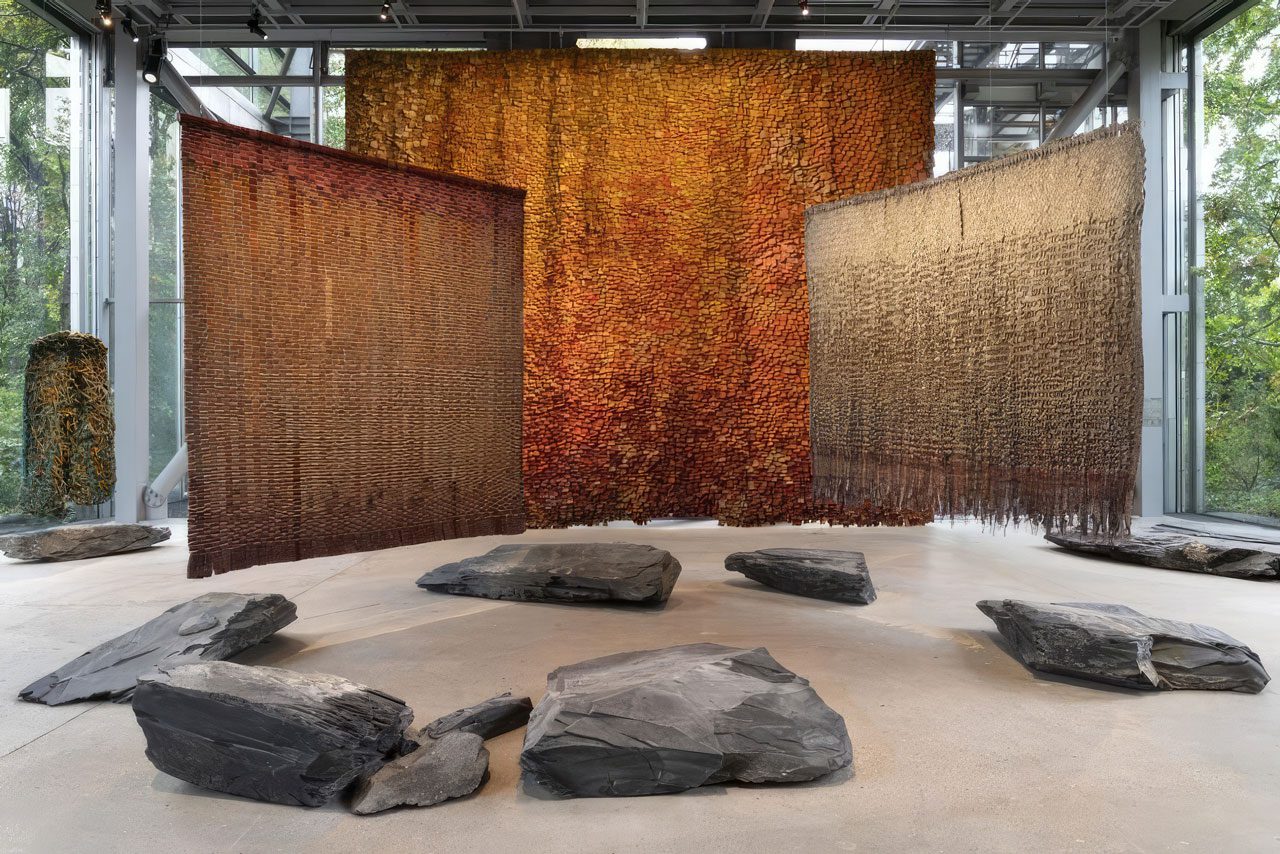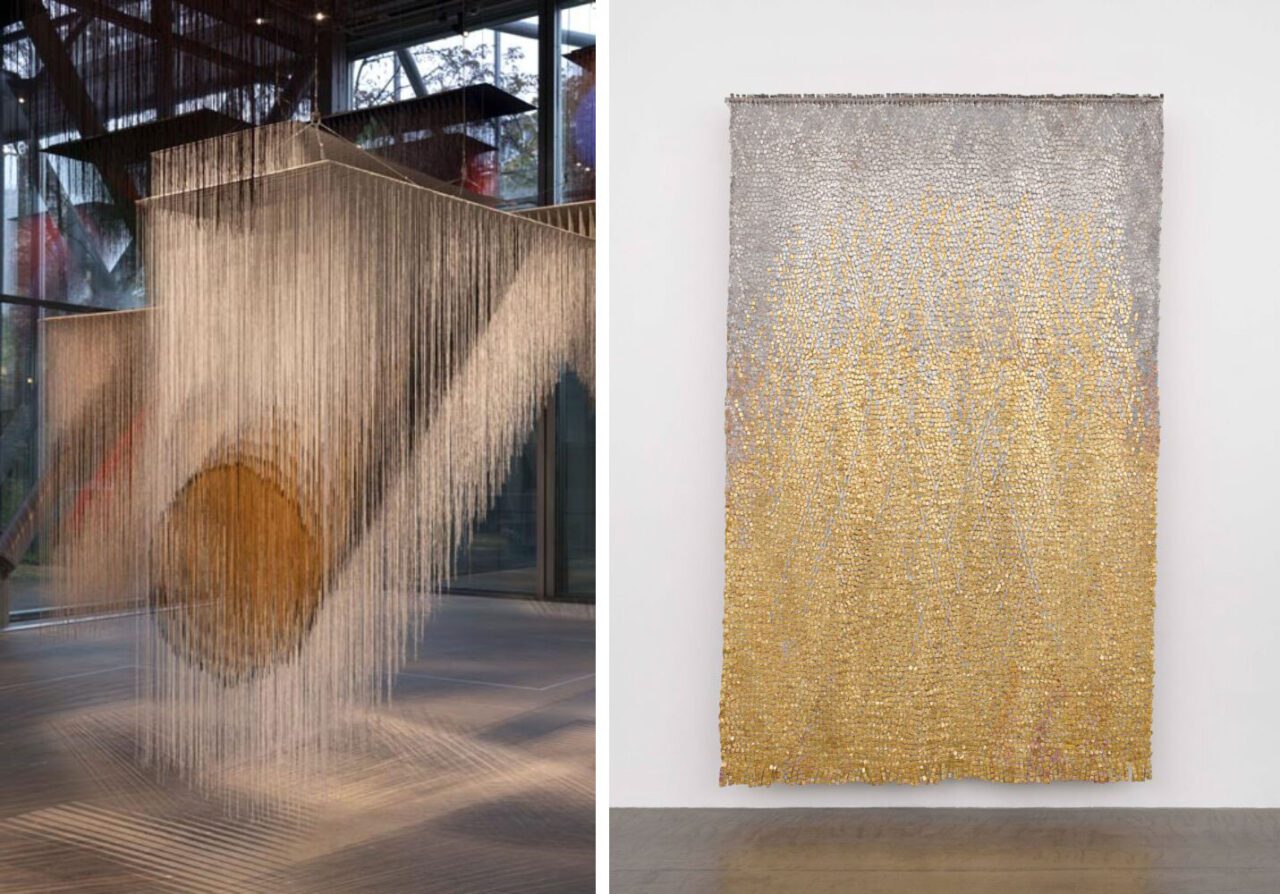ART CITIES: Paris-Olga de Amaral
 Olga de Amaral is a Colombian textile artist known for her site-specific installations utilizing materials such as gold leaf, fiber glass, and paint along with traditional fibers to create three-dimensional installations. These works are either hung flat upon the wall like a painting, or suspended from the ceiling like clouds with transparent architectural supports. Amaral’s inspiration comes from a variety of sources, including her native landscape, pre-Colombian textiles and baskets, gold Catholic Church relics, and geometric abstraction.
Olga de Amaral is a Colombian textile artist known for her site-specific installations utilizing materials such as gold leaf, fiber glass, and paint along with traditional fibers to create three-dimensional installations. These works are either hung flat upon the wall like a painting, or suspended from the ceiling like clouds with transparent architectural supports. Amaral’s inspiration comes from a variety of sources, including her native landscape, pre-Colombian textiles and baskets, gold Catholic Church relics, and geometric abstraction.
By Efi Michalarou
Photo: Fondation Cartier pour l’art contemporain Archive
The first major retrospective in Europe of Olga de Amaral brings together nearly eighty works made between the 1960s and now, many of which have never been shown before outside of Colombia. Beyond the vibrant goldleaf pieces for which the artist is renowned, the exhibition reveals her earliest explorations and experimentations with textile, as well as her monumental works. In the 1960s and 1970s, alongside Sheila Hicks and Magdalena Abakanowicz, Amaral contributed to the development of Fiber Art, using new materials and techniques drawing equally from Modernist principles and the folk traditions of her native country. Her large-scale abstract works free themselves from the wall and refuse any form of categorization. Olga de Amaral has pushed the limits of the textile medium by increasing experiments with various materials (linen, cotton, horsehair, gesso, gold leaf or palladium) and techniques: she weaves, knots, braids, and interweaves the threads to create monumental, three-dimensional pieces. Unclassifiable, her work borrows as much from the Modernist principles she discovered at the Cranbrook Academy in the United States, as from the vernacular traditions of her country and from pre- Columbian art. After presenting six works from the “Brumas” series as part of the “Southern Geometries” exhibition in 2018, the Fondation Cartier retraces Olga de Amaral’s entire career and celebrates a figure who brought about a true revolution in the textile arts. Olga de Amaral studied architectural design at Colegio Mayor de Cundinamarca, prior to attending Cranbrook Academy of Art in the United States, where she majored in weaving and textile design. As the founder of the Textile Department at the Universidad de los Andes in Bogotá, Amaral established her international reputation in the late 1960s. The artist spins base matter into fields of color and weaves tectonic lines through space, unselfconsciously testing the borders between crafted object and the work of art. From the flat surfaces of tapestry through to resolutely three-dimensional sculptural forms made from fibre, the Colombian artist’s work spans more than 60 years, in turn reaching even further back to the spiritual qualities and ancient craquelure of medieval icon paintings or else the rigour and simplicity of the modernist grid, as if run through a loom. Developing her own tools and techniques, while relying on the hand for her strip-woven expanses of wool, linen and cotton, Amaral has also knotted reams of horsehair together and bolstered her fabric works through a painterly application of gesso or stucco, often highlighting the reverse, or foregrounding the edges. Working not only on the floor or the wall, Amaral carves up interiors with her hanging tapestries, creates floating formations from yarn or plastic, while following nature’s lead for outdoor works such as “Hojarascas” (Dried Leaves), begun in the 1970s, or working at architectural scale, for the creation of the six-story façade commission, “El Gran Muro” (The Great Wall), in 1976. Amaral’s travels in the 1950s and ’60s are reflected in her wide range of international influences. After an encounter with the Japanese technique of ‘kintsugi’ at the ceramics studio of British potter Lucie Rie in 1970, for example, Amaral began a series of “Fragmentos Completos” (Complete Fragments) employing gold leaf, layered and intertwined within the fabric of her hand-woven textiles. Amaral’s work also references religious and ceremonial dimensions prescribed to gold through the pre-Columbian worship of the substance, especially in her “Alquimia” (Alchemy) works begun in 1984, which reclaim the notion of a material indelibly connected to the sun and the earth, but equally plundered from her country over many centuries.
Photo: Olga de Amaral, Exhibition view, © Olga de Amaral. Courtesy Lisson Gallery
Info: Curator: Marie Perennès, Fondation Cartier pour l’art contemporain, 261 Boulevard Raspail, Paris, France, Duration: 12/10/2024-16/3/2025, Days & Hours: Tue 11:00-22:00, Wed-Sun 11:00-20:00, www.fondationcartier.com/




